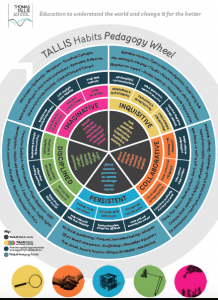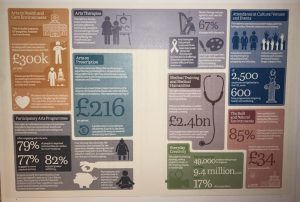As I made my way into the first lecture of Integrated Arts, it is fair to say I was feeling fairly pessimistic and anxious . After having both good and bad experiences in my prior education in the arts, I was worried that I would not be “talented” enough to excel in this class. However, I have learned the main aim of this module is to allow us, as both students and teachers, to reconstruct our attitudes to teaching the arts and broaden our experiences in expressive arts areas, rather than solely attempting to enhance our own creative skills.
We were introduced to various academic readings related to the creative arts. One of which was the Tallis Habits Pedagogy Wheel (Thomas Tallis School, 2017). This gives us an insight into how to develop and implement the arts  throughout the school curriculum through encouraging a number of habits, such as being imaginative, inquisitive, collaborative and persistent. The outer segments of the wheel relate specifically to strategies teachers can employ that enable students to deliberately strengthen their habits of mind. I felt this was particularly useful to me, as an aspiring teacher, because it highlights how complex yet valuable teaching the arts and nurturing learners’ creativity are. I appreciate that pedagogy of more traditional subjects, such as literacy and mathematics, have various methods and strategies however I feel the intricacy of teaching in the arts really challenges an educator’s commitment to not only discover a learner’s talents and strengths but also their own.
throughout the school curriculum through encouraging a number of habits, such as being imaginative, inquisitive, collaborative and persistent. The outer segments of the wheel relate specifically to strategies teachers can employ that enable students to deliberately strengthen their habits of mind. I felt this was particularly useful to me, as an aspiring teacher, because it highlights how complex yet valuable teaching the arts and nurturing learners’ creativity are. I appreciate that pedagogy of more traditional subjects, such as literacy and mathematics, have various methods and strategies however I feel the intricacy of teaching in the arts really challenges an educator’s commitment to not only discover a learner’s talents and strengths but also their own.
We were also introduced to a report called Creative Health: The Arts for Health and Wellbeing (2014). This report explains how powerful the contribution of the arts has on health and well being. It suggests that the arts can help keep u s well, aid our recovery and support longer lives better lived and also help meet major challenges facing health and social care. Before reading this report, my understanding of how significantly the arts impact on the lives of people was limited. My prior understanding was that participation in the arts was merely a hobby and something that people did not necessarily need to develop their academic growth or maintain their heath. I now realise that is not the case and I understand how important learning in and through the arts really is.
s well, aid our recovery and support longer lives better lived and also help meet major challenges facing health and social care. Before reading this report, my understanding of how significantly the arts impact on the lives of people was limited. My prior understanding was that participation in the arts was merely a hobby and something that people did not necessarily need to develop their academic growth or maintain their heath. I now realise that is not the case and I understand how important learning in and through the arts really is.
I now feel I have a strong foundation of knowledge to begin my learning in the Integrated Arts module. Also, it has now been made clear to me that teaching the expressive arts is not about how well you can paint, or act, or dance, or sing. It is about giving every child an opportunity to learn in different ways and it does not necessarily matter how advanced your skills are or how experienced you are in the expressive arts. I look forward to experiencing what else the Integrated Arts module has in store.
References
Thomas Tallis School. (2017) The TALLIS Habits Pedagogy Wheel. [Online] Available: http://www.thomastallisschool.com/tallis-pedagogy-wheel-guide.html [Accessed 12 September 2017].
The All-Party Parliamentary Group on Arts, Health and Wellbeing (2014) Creative Health: The Arts for Health and Wellbeing. [Online] Available: http://www.artshealthandwellbeing.org.uk/appg-inquiry/Publications/Creative_Health_The_Short_Report.pdf [Accessed 12 September 2017].

